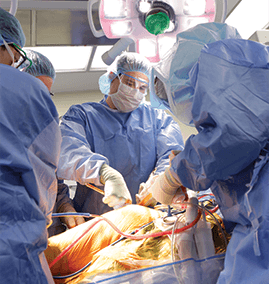Hip & Knee Reconstruction
Innovative Surgical Techniques

Dr. Jeffrey A. Geller
Chief, Division of Hip and Knee Reconstruction
-
Our hip arthroplasty specialists have particular expertise in anterior approach hip replacement, a muscle-sparing surgery in which the surgeon makes the incision toward the front of the hip joint. This approach can also facilitate the use of fluoroscopy to ensure the new hip is implanted in an optimal position specific for that patient. Our program performs a much higher percentage of anterior approach hip replacements than anywhere in the greater New York region and has been doing this approach for many years.
-
In selected patients, our orthopedic surgeons emphasize natural anatomy-sparing knee replacement surgery that retains the posterior and anterior cruciate ligaments. This technique, while technically more complex than standard knee replacement surgery, potentially allows for a more stable and natural feel to the knee than is experienced with conventional techniques. They are currently participating in a multicenter trial to gauge the success of this approach and patients’ ability to maintain full joint stability and a return to sports and normal living activities more quickly.
-
To mitigate pain in joint replacement surgery – particularly in the knee – our orthopedic surgeons use a range of novel pain management approaches, including commencement of pain medication just prior to surgery followed by a combination of innovative nerve blocks and local anesthetics. Our team of experts place high priority on preventing pain before it starts to enable our patients to get up and resume walking immediately.
At one year, our joint replacement patients report postoperative improvements in pain, stiffness, and function.

Our surgical site infection rate for hip replacement is 60% less than the national benchmark.

Research Highlights
-
A study by Columbia surgeons published in the August 9, 2017 issue of the Journal of Orthopaedics showed that patients with isolated compartment radiographic disease but with bicompartmental symptoms can benefit from unicompartmental knee arthroplasty and simultaneous arthroscopy.
-
Publishing widely on clinical outcomes and complications of hip and knee replacements, Columbia orthopedic surgeons have a particular focus on the diagnosis and management of periprosthetic joint infection, implant loosening, bearing surface wear, and osteolysis, as well as periprosthetic fractures. Their expertise on corrosion at modular junctions in total hip arthroplasty and the body’s reaction to metal wear debris is frequently presented at national and international orthopedic meetings.
-
In a study evaluating the use of an electronic sensor device during trialing of total knee arthroplasty, Columbia surgeons demonstrated improved ligamentous balancing with a statistically significant reduction in the rate of manipulation under anesthesia for patients with early arthrofibrosis. Results were published in the May 2017 issue of the Journal of Arthroplasty.



